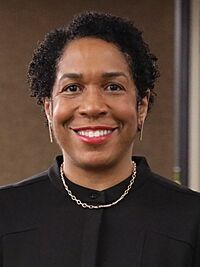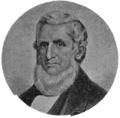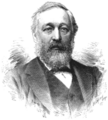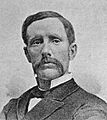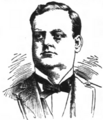Lieutenant Governor of Illinois facts for kids
Quick facts for kids Lieutenant Governor of Illinois |
|
|---|---|
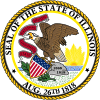
|
|
| Government of Illinois | |
| Term length | 4 years, no term limits |
| Inaugural holder | Pierre Menard |
| Formation | 1818 |
| Succession | First |
| Salary | $139,200 |
The lieutenant governor of Illinois is the second most important leader in the State of Illinois government. Think of them as the governor's main helper. In Illinois, the lieutenant governor and the governor run for office together. This means people vote for them as a team.
Candidates for governor choose their running mates (the person they want as lieutenant governor) before the election. They appear on the ballot together. If the governor of Illinois cannot do their job, the lieutenant governor steps in as acting governor. If the governor leaves office for good, the lieutenant governor becomes the new governor. The current lieutenant governor is Juliana Stratton, who is a Democrat.
Before 1970, governors and lieutenant governors were elected separately. This sometimes led to them being from different political parties. Now, they run together to make sure they can work as a team.
Contents
What the Lieutenant Governor Does
The lieutenant governor of Illinois has many important jobs. These jobs are given to them by state laws.
Key Responsibilities
Some of their main duties include:
- Leading the Governor's Rural Affairs Council. This group helps people in the countryside.
- Being in charge of the Rural Bond Bank of Illinois. This bank helps rural areas get money for projects.
- Leading the Illinois Main Street Program. This program helps improve downtown areas.
- Chairing the Illinois River Coordinating Council. This group works to protect the Illinois River.
Other Important Tasks
The lieutenant governor can also take on other tasks. The governor might ask them to work on specific projects. Or, the lieutenant governor can start their own projects. For example, former Lt. Gov. Corrine Wood worked on women's health issues. The lieutenant governor also travels around the state. They speak for the governor and represent the state government. They are also part of the National Lieutenant Governors Association. This is a group for lieutenant governors across the country.
Before 1970, the lieutenant governor also led the Illinois Senate. Losing this role made the job seem less important to some. For example, Dave O'Neal resigned in 1981 because he found the job boring.
If the lieutenant governor's office becomes empty, it stays empty until the next election. This happened when Pat Quinn became governor. The office was empty until Sheila Simon was elected.
The lieutenant governor has offices in both Springfield and Chicago. These are the two main cities where state government work happens.
How to Become Lieutenant Governor
To be the lieutenant governor of Illinois, a person must meet certain requirements. They serve for four years. The new lieutenant governor starts their term in January after the election.
Qualifications Needed
To qualify, a person must be:
- At least 25 years old.
- A citizen of the United States.
- A resident of Illinois for at least three years before the election.
- They cannot hold other government jobs while serving as lieutenant governor.
Images for kids


